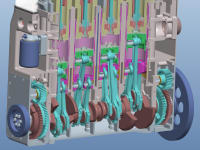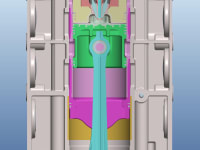The insulated pulse-combustion engine is a reciprocating piston engine concept which explores the five pathways of non-productive energy export from internal combustion engines (thermal conduction, exhaust heat, exhaust pressure, exhaust pollution, and mechanical losses) in an effort to improve fuel economy. This concept combines principle attributes of the Diesel engine (unthrottled induction and high compression ratio), of ceramic adiabatic engine prototypes of the early 1980s (thermal insulation), of current HCCI engine prototypes (isochoric heat addition), and of Ernest Chatterton’s “Simplic” 2-stroke engine prototype (isobaric heat rejection).
Several key philosophies of Chatterton’s Simplic engine, as documented in the 1975 book by L.J.K. Setright entitled, "Some Unusual Engines", are reprised in the IPC engine concept, including hyper-extended expansion cycle, induction preceding exhaustion, uniflow gas transfer, aversion to supercharging, and no cooling system.
The IPC engine’s thermodynamic sequence, often known as the Humphrey cycle, provides opportunity for high thermal efficiency, however it also carries the penalty of comparatively low volumetric efficiency, necessitating that mechanical losses be commensurately downscaled to realize benefit.
Compared with naturally-aspirated 4-stroke Diesel engines at full throttle, a similarly displaced 2-stroke IPC engine at full throttle consumes a twelfth of the fuel each combustion event. This is based on the observation that HCCI prototype engines consume 1/4 of the full throttle fuel that similarly displaced Diesel engines consume each combustion event, and that only 1/3 of a piston stroke in the IPC engine applies to the compression cycle.
The IPC engine’s combustion chamber must become fuel-stratified at 30BTC, whereupon fuel is direct-injected into a central region of the chamber. Fuel is constrained to, and mixed within, the central region using tumble-turbulence generated by inducted air surging inward from a fuel-devoid perimeter region. Fuel stratification, in conjunction with spark or other precision ignition method, permits throttling a locally-homogenous fuel-air equivalence ratio within the highly reactive range of 0.40-0.80 to assure a rapid, complete combustion reaction with practical torque band.
Combustion initiates centrally at TDC, propagates radially outward a short distance on a controlled supersonic wavefront, whereupon the reaction efficiently concludes near TDC, assuring the entire fuel budget performs work on the piston through the full expansion cycle. Expansion is hyper-extended to 2/3 of the piston stroke, extracting all available combustion energy and eliminating the need for a cooling system. Chamber vacuum then develops which draws fresh inducted air into the bottom 1/3 of the chamber. At BDC, induction ends and the piston begins quietly exhausting oxygen-rich combusted gasses residing in the upper 2/3 of the chamber.
Conventional emissions control devices are not effective at scrubbing pollutants from the resulting cool, pressureless exhaust gasses. The IPC engine must prevent the formation of pollutants by constraining fuel to a turbulent, thermally-insulated, crevice-free region of the combustion chamber specifically shaped (only at TDC) to support clean combustion. Rather than using brittle ceramic thermal insulators, the IPC engine contains two thermally-insulating Fe60Ni40 alloy steel disks, one integrally cast into the piston, the other into the cylinder head, to prevent the formation of quench-sourced pollutants.
Video
Like this entry?
-
About the Entrant
- Name:Dave Schouweiler
- Type of entry:individual
- Software used for this entry:Creo Elements/Pro
- Patent status:pending








